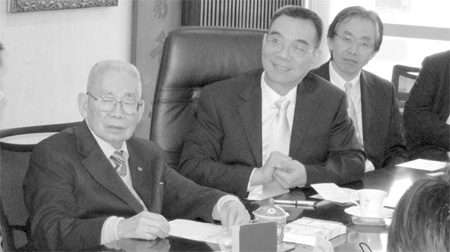Justin Lin: China can maintain 8% GDP growth for 2 decades
Updated: 2011-03-24 07:02
By Joy Li(HK Edition)
|
|||||||||
|
World Bank Chief Economist and Senior Vice President Justin Yifu Lin (center) visited Hong Kong entrepreneur and philanthropist Fong Yun-wah (left) after attending the China Economic Development Forum on Wednesday. Guo Jiaxue / China Daily |
China can maintain 8 percent annual economic growth for the next two decades, which would help it replace the US as the world's largest economy if the country can overcome various challenges, said Justin Yifu Lin, chief economist at the World Bank.
But amid the prospects of fast growth, Lin warned that income disparity is at the root of challenges facing the country. He made his comments during a speech at the China Economic Development Forum in the city, an event organized by the Hong Kong University of Science and Technology.
Over the past 20 years, thanks to an annual average GDP growth of 10.4 percent, China overtook Japan last year as the world's second-largest economy, accounting for 9 percent of global output.
China has set a 7 percent annual growth target in the recently announced 12th Five-Year Plan.
Lin estimated that in 2030, per capita income in China will be half that of the US, up from 21 percent in 2009. By then, China's population will be 4.5 times that of the US, which means the size of its economy will be twice as large, Lin added.
However, after the global financial crisis of 2008, China is faced with a set of challenges which Lin described as "triple imbalances". They include imbalances between domestic consumption and exports, between the rich and the poor when its comes to the distribution of social wealth, and between short-term economic growth and long-term environmental sustainability, according to Lin.
"The root of these internal and external imbalances is income disparity," said Lin.
The Gini coefficient - a measure of income inequality - reached 0.47 in the country last year, overshooting the recognized warning level of 0.4.
A low Gini coefficient indicates a more equal distribution, with 0 corresponding to complete equality and 1 complete inequality.
"The Gini coefficient in China has been continuously rising even after it reached an alarming 0.4-level 10 years ago," Chang Xiuze, a researcher with the academy of microeconomic research under the National Development and Reform Commission said last May.
Li Daokui, an economics professor at Tsinghua University, told the same forum on Wednesday that mounting social tensions is the most fundamental challenge facing the country, with income disparity one of the underlying factors.
"The situation in China is somewhat like that in Latin American countries and there is no clear sign of this reversing," said Li.
To address these challenges, "there is a need to finish the transition towards a market economy," Lin stressed.
He called for more complete reforms in areas such as the financial sector, where large state-owned enterprises are favored when seeking credit.
Tsinghua University's Li believes that China has entered a new era of reform and "we can reasonably expect a large number of reforms to mitigate social tension". For example, new criteria to assess local government officials - whose career prospect is primarily tied to GDP growth under the current system - will be rolled out in the future to adjust local governments' behavior, he said.
China Daily
(HK Edition 03/24/2011 page2)
